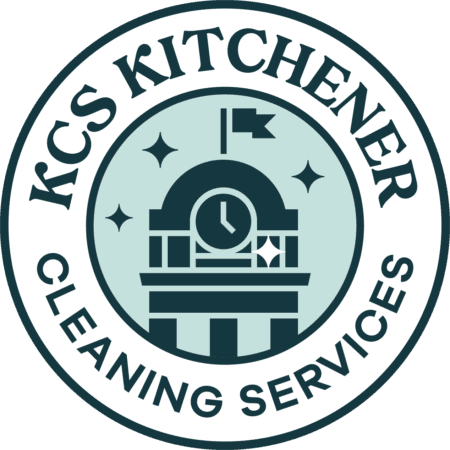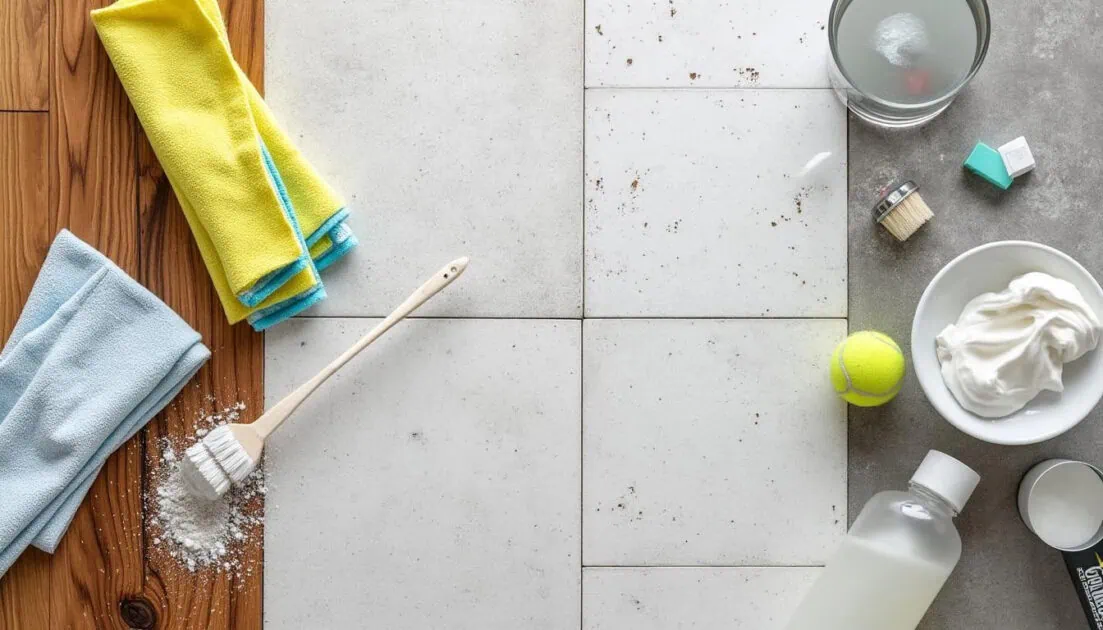You’ve tried everything. Magic erasers, baking soda paste, that weird toothpaste trick your neighbour swears by. Nothing works. Those marks are still there, laughing at you.
Here’s what nobody tells you: most online cleaning advice is garbage. Those Pinterest tutorials? They don’t explain why their tricks fail half the time. Professional cleaners know something the rest of us don’t.
Different surfaces need different approaches. Period. Rubber marks aren’t the same as metal scrapes. Fresh damage responds to gentle treatment. Old, set-in marks? You need bigger guns.
Most homeowners waste entire weekends trying random cleaning tricks that either don’t work or damage expensive surfaces. The real frustration? Those online tutorials never explain why their tricks fail or what works for different surface types.
Whether you’re cleaning up after a move, dealing with daily wear, or trying to impress your in-laws, these tricks protect your surfaces while getting rid of those annoying marks. While you’re at it, cleaning baseboards properly prevents the same dirt buildup that creates scuff marks in the first place. Skip the trial-and-error phase. Get it right the first time.
Why Different Materials Create Different Problems
Most people think all scuff marks are identical. Wrong. The stuff making the mark, plus your surface type, decides what removal trick actually works. Miss this connection and you’ll waste hours.
Smart cleaners figure out what they’re dealing with first. Saves time. Prevents damage from using the wrong approach.
Rubber vs Metal
Here’s what actually happens with rubber marks. Rubber soles create marks through polymer transfer and thermal compression. When rubber compounds come into contact with surfaces, frictional heat reaches 150-200°F. This heat bonds the rubber to paint or flooring finish.
Trust me, this science matters. Standard cleaning tricks fail because covalent bonds form between rubber molecules and the polymers in paint. Water-based cleaners, soap solutions, and basic scrubbing can’t break these chemical connections.
Metal objects create marks through surface abrasion and the transfer of metallic residue. Chair legs, furniture casters, and appliance edges scrape away protective coatings while depositing microscopic metal particles into surface pores. These marks go deeper than rubber marks. They need different treatment.
Rubber marks need solvents or gentle abrasives to break the rubber bond. Metal marks need careful abrasion to remove metal traces without deepening scratches.
Fresh Marks vs Set-In Damage
Fresh marks sit on your surface. Set-in marks bond with your surface material. This bonding happens through heat, time, or chemical interaction. Fresh marks clean easily. Bonded marks need aggressive treatment.
Test the mark by gently wiping it with a damp cloth. Fresh marks lighten or disappear immediately. Set-in marks remain unchanged or show only slight improvement.
Age affects removal success dramatically. Fresh marks respond to mild cleaners and gentle pressure. Set-in marks need stronger solvents, longer dwell time, or mechanical removal tricks.
Remove Floor Scuff Marks with Methods That Actually Work
Floor scuff marks frustrate homeowners because generic cleaning advice often overlooks the fact that different flooring materials require distinct treatments. Hardwood, tile, vinyl, and laminate each need specific approaches. Use it the wrong way and you’ll damage expensive flooring.
These tricks stem from years of professional experience with various flooring materials and marking types.
Hardwood and Engineered Wood
Hardwood needs gentle treatment to preserve finish integrity. Start with the mildest approach that works for you. Water-based cleaners work for surface marks. Avoid petroleum-based products that damage wood finishes.
Create an alkaline cleaning paste by mixing three parts baking soda with one part water to remove persistent rubber marks. Here’s the chemical pH 9. This pH-9 solution provides mild abrasive neutralising acidic rubber compounds. Apply gently with a soft cloth using circular motions. Rinse thoroughly with clean water.
For metal marks, try the pencil eraser trick. Clean rubber erasers remove light metal traces without damaging wood. Use gentle pressure and work in small sections.
Test cleaning tricks in hidden areas first. Some wood finishes are unpredictable in their reactions to cleaning products. If marks persist after gentle approaches, consider consulting a professional for refinishing rather than attempting aggressive DIY methods.
Tile and Stone
Tile surfaces handle stronger cleaning tricks than wood, but grout needs careful protection. Use pH 6.5-7.5 cleaners to maintain the integrity of cement-based grout. Alkaline cleaners with a pH above eight can cause efflorescence and structural weakening. Acidic solutions with a pH below 6 create permanent chemical etching.
For rubber marks on tile, use a plastic scraper to remove bulk material first. Follow with degreasing dish soap and warm water. The surfactants in dish soap break down rubber compounds without the use of harsh chemicals.
Stone surfaces like marble or travertine need acid-free cleaners. Avoid vinegar, lemon juice, or commercial cleaners containing acids. These products etch natural stone permanently.
Vinyl and Laminate
Vinyl and laminate flooring feature protective wear layers that dull when cleaned improperly. These synthetic materials handle different cleaning tricks than natural materials.
Remove scuff marks with clean tennis balls for controlled abrasive action. Tennis ball felt provides the perfect texture density to lift rubber residue without penetrating protective wear layers. This works particularly well for rubber sole marks.
For stubborn marks, use isopropyl alcohol on a soft cloth. Alcohol dissolves many mark-causing substances without affecting vinyl or laminate finishes. Apply alcohol sparingly and wipe dry immediately to prevent spotting.
Magic Erasers work well on vinyl, but test them first in hidden areas. Some vinyl formulations react poorly to melamine foam, causing permanent dulling or texture changes.
Wall Scuff Mark Removal Without Damaging Paint
Wall scuff marks can be challenging for homeowners because paint types and finishes react differently to cleaning techniques. Here’s what I’ve learned: Flat paint lacks protective polymer barriers and shows damage easily, but absorbs cleaning solutions. Semi-gloss paint’s protective acrylic coating hides marks better, but excessive mechanical action creates permanent burnishing.
Know your paint type to guide approach selection. Most homes use flat paint in low-traffic areas and semi-gloss in high-traffic zones. Each needs different cleaning approaches.
Test Paint Durability First
Paint testing prevents visible damage to prominent wall areas. Choose a hidden spot, like behind furniture or inside closets. This testing reveals how your specific paint responds to cleaning tricks.
Start with the gentlest approach possible. A damp cloth with plain water removes fresh marks without affecting the paint. If water cleaning fails, gradually increase cleaning intensity while monitoring paint reaction.
Flat Paint vs Semi-Gloss
Flat paint offers no surface protection and is easily damaged during cleaning. Use minimal moisture and gentle pressure to avoid creating permanent shiny spots or texture changes.
Magic erasers work well on flat paint but need light pressure. Heavy pressure burnishes the paint surface, creating permanent shiny patches that stand out against the matte finish.
For flat paint marks, try the bread trick first. Fresh white bread gently removes marks through mild abrasion without affecting the paint finish. Roll the bread into a ball and gently rub the marked area.
Semi-gloss paint responds well to degreasing cleaners like dish soap solutions. The protective finish prevents cleaner penetration while allowing removal.
Eco-Friendly Scuff Removal That is Safe for Pets and Kids
Many commercial cleaners contain harsh chemicals that pose risks to pets and children. Green cleaning ways work as well as chemical alternatives for scuff mark removal.
Look, the chemistry here is simple. White vinegar removes many scuff marks through acidic dissolution of alkaline rubber compounds. Mix equal parts water and white vinegar for general cleaning. This solution works particularly well on painted surfaces and hard flooring.
Baking soda creates effective cleaning pastes for stubborn marks. Mix with small amounts of water to form abrasive pastes. This mild abrasive removes marks without surface damage when used properly.
Even eco-friendly approaches need proper ventilation during use. Keep pets away from cleaning areas until the surfaces are completely dry.
Scuff Mark Prevention to Save Hours of Cleaning Time
Professional cleaners know that prevention costs less than removal. Smart planning cuts down scuff mark formation dramatically.
Once you set these approaches up, they provide long-term protection with minimal maintenance needs. Trust me, the upfront effort pays off big time.
Smart Furniture Placement
Position furniture 2-4 inches from walls where possible. This minimum clearance prevents chair backs, desk edges, and table corners from creating contact pressure during normal movement patterns. Even small gaps make significant differences in mark prevention.
Use furniture pads on pieces that must sit against walls. Felt pads create soft barriers between hard furniture edges and painted surfaces. Replace pads when they become compressed or dirty.
Seasonal Maintenance
Schedule monthly preventive cleaning before marks become permanent. Here’s the thing about timing: Rubber compounds bond chemically within 14 to 21 days of initial contact. After this point, you need 3x more aggressive removal approaches. The same goes for preventing baseboard buildup. Regular maintenance prevents problems that require aggressive intervention later.
Inspect high-risk areas quarterly for early mark detection. Early identification allows gentle removal approaches that protect surfaces.
When DIY Tricks Fail
Recognising DIY limitations prevents expensive damage from continued attempts. Some surface damage needs specialised treatment beyond DIY capabilities.
Recognising Surface Damage That Needs Professional Repair
Scratches deeper than 0.5mm that catch fingernails penetrate through protective topcoats into substrate materials. These structural defects need professional assessment. Topical treatments can’t restore material integrity in compromised surface layers.
Discolouration that persists after multiple cleaning attempts indicates permanent staining or material degradation. A professional evaluation determines whether restoration is possible or replacement is necessary.
Water damage signs like bubbling, peeling, or darkening need immediate professional attention. Continued exposure to moisture can lead to expensive structural problems that require more than cosmetic repair.
Finding Qualified Local Cleaning Services
Research local companies with specific surface cleaning experience. General cleaning services often lack the expertise required for challenging mark removal. Specialised knowledge provides better outcomes.
Services like KCS Kitchener Cleaning Services specialise in addressing challenging residential cleaning situations, including the removal of scuff marks from various surfaces. Their experience with move-in and post-construction cleaning provides expertise with difficult mark removal situations.
Get detailed written estimates, including the scope of work and guarantee terms. Clear agreements prevent misunderstandings and ensure the delivery of appropriate services.
Building Your Essential Toolkit
Successful mark removal needs appropriate tools readily available when needed. Building a comprehensive toolkit prevents delays when marks appear.
Keep these essentials ready: microfiber cloths, baking soda, white vinegar, isopropyl alcohol (70% concentration for best cleaning power), soft-bristled toothbrushes, and plastic scrapers. Many of these work for dusting and wiping baseboards as well. These versatile supplies effectively handle multiple cleaning challenges.
Generic cleaning products perform as well as name brands at significant cost savings. Household items like baking soda, vinegar, and dish soap can handle most cleaning challenges at a fraction of the cost of speciality products.
Taking Action on Your Scuff Mark Problems Today
Stop wasting weekends on cleaning tricks that don’t work. You now know the science behind different mark types, which surfaces need gentle treatment versus aggressive approaches, and how to prevent future damage through smart furniture placement and regular maintenance. Material identification drives everything – rubber polymer bonds need different treatment than metal abrasion marks, and your surface type determines safe cleaning limits.
When DIY approaches fail or you’re dealing with expensive surfaces you can’t risk damaging, that’s when professional expertise pays off. KCS Kitchener Cleaning Services specialises in challenging residential cleaning situations, including stubborn scuff mark removal from all surface types. Their experience with move-in cleaning and post-construction projects means they’ve seen every type of mark damage and know exactly which approaches work without risking your investment.
Ready to get those stubborn marks gone for good? Contact KCS Kitchener Cleaning Services today and skip the trial-and-error frustration – let the professionals handle it while you get your weekend back.
This analysis is for informational purposes only and should not be considered professional cleaning advice. Surface materials and cleaning product formulations change frequently. Consult current official sources and qualified cleaning professionals for up-to-date information.


